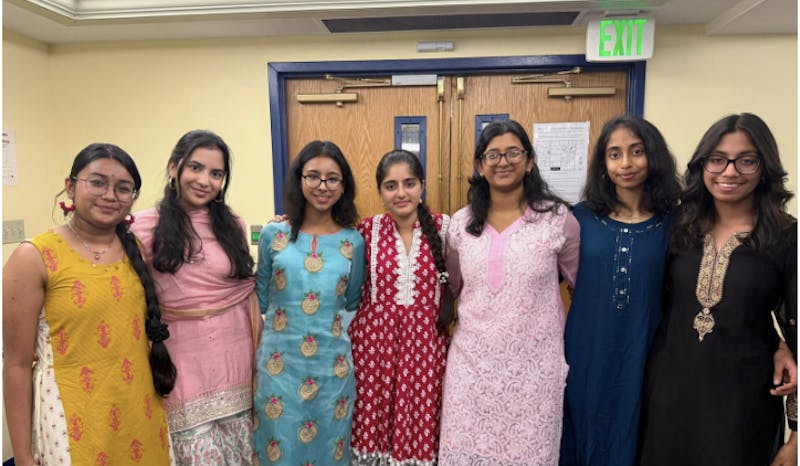Science
Students Celebrate Diwali Away from Home with Unique Traditions

As college students adjust to life far from home, some find themselves yearning for familiar traditions. This was the case for students at Johns Hopkins University who celebrated Diwali on November 16, 2025, in a way that blended their cultural heritage with the realities of campus life. The students transformed the McCoy lounge into a vibrant space filled with laughter, music, and the spirit of the festival.
For many, this year’s Diwali was a stark contrast to previous celebrations. Vidhi Bansal, a freshman from Upper Saddle River, N.J., reflected on her past experiences celebrating the festival with her family. “Last year, I was too busy with college applications to truly engage with the festivities,” she recounted. “This year, being away from home made me realize how much I missed the rituals and the warmth of family gatherings.”
Bansal’s phone buzzed with a reminder from her mother, instructing her to honor the day by joining in the family’s rituals via video call. Despite the distance, her parents managed to light 21 diyas at home, creating a scene that felt both familiar and distant for Bansal. The call only heightened her sense of longing, as she described to her roommate the decorations, the aroma of home-cooked meals, and the joyous chaos that typically characterized her family’s Diwali celebrations.
In an effort to recreate some of that magic, Bansal and her friends initiated a group chat to organize their own celebration. The excitement in the air was palpable as they prepared to host a gathering. “I knew I didn’t want to miss it again,” she said. The next evening, the McCoy lounge buzzed with energy as students donned traditional clothing and brought together a mishmash of snacks, from Lays to laddoo for prasad.
Creating Community Through Tradition
The evening began with a sense of novelty as students arrived in a mix of attire, some dressed in traditional kurtas and lehengas, while others opted for casual wear. They scoured local stores for tealight candles, which they arranged on paper plates to simulate the ambiance of home. As the group expanded from five to twenty, the initial awkwardness faded, replaced by a sense of community.
When it came time for the aarti, Bansal rushed to her room to retrieve her family’s Bhagwanji figures, attempting to recreate the sacred atmosphere of her home. “We took off our shoes and formed a circle, fumbling through the words and gestures,” she recalled. The group found solace in shared familiarity, even as they navigated the ritual with varying degrees of experience.
A YouTube video of the Ganesha Aarti played in the background, adding to the authenticity of the moment. Laughter filled the room when one student asked how many circles she usually completed during the ritual. “Just until I feel like it, then I give it to my mom,” Bansal shrugged, prompting smiles all around.
As the festivities progressed, the atmosphere shifted from solemnity to celebration. The students took to their phones, connecting a Bluetooth speaker to fill the room with Bollywood music. They danced barefoot, substituting their iPhone flashlights for the diyas they could not light. “It was a Diwali unlike any I’d known—imperfect, improvised, but unmistakably ours,” Bansal reflected.
Redefining Home and Belonging
This unique celebration offered Bansal a new perspective on what it means to grow and adapt while holding onto one’s heritage. “I began to understand how growing up doesn’t have to mean leaving home behind,” she noted. “It means learning how to rebuild it wherever you go, translating rituals instead of replacing them.”
As the night drew to a close, Bansal returned to her studies, feeling a renewed sense of belonging. “We hadn’t recreated home perfectly, but we had all at least tried,” she said. The experience reminded her that cultural traditions can thrive even in new environments, adapting to fit the context without losing their essence.
For students like Bansal, the celebration of Diwali in a college setting illustrates that even when far from home, the bonds of community and tradition can remain strong. This year’s festivities were a testament to resilience and creativity, ensuring that cherished customs continue to flourish, regardless of geographical distance.
-

 Science2 weeks ago
Science2 weeks agoUniversity of Hawaiʻi Joins $25.6M AI Project to Monitor Disasters
-

 Business3 weeks ago
Business3 weeks agoForeign Inflows into Japan Stocks Surge to ¥1.34 Trillion
-

 Top Stories3 weeks ago
Top Stories3 weeks agoMarc Buoniconti’s Legacy: 40 Years Later, Lives Transformed
-

 Top Stories3 weeks ago
Top Stories3 weeks agoBOYNEXTDOOR’s Jaehyun Faces Backlash Amid BTS-TWICE Controversy
-

 Health3 weeks ago
Health3 weeks agoInnovative Surgery Restores Confidence for Breast Cancer Patients
-

 Sports1 month ago
Sports1 month agoSteve Kerr Supports Jonathan Kuminga After Ejection in Preseason Game
-

 Science1 month ago
Science1 month agoChicago’s Viral ‘Rat Hole’ Likely Created by Squirrel, Study Reveals
-

 Lifestyle1 month ago
Lifestyle1 month agoKelsea Ballerini Launches ‘Burn the Baggage’ Candle with Ranger Station
-

 Entertainment1 month ago
Entertainment1 month agoZoe Saldana Advocates for James Cameron’s Avatar Documentary
-

 Top Stories3 weeks ago
Top Stories3 weeks agoCarson Wentz Out for Season After Shoulder Surgery: Urgent Update
-

 Politics1 month ago
Politics1 month agoDallin H. Oaks Assumes Leadership of Latter-day Saints Church
-

 Lifestyle1 month ago
Lifestyle1 month agoDua Lipa Celebrates Passing GCSE Spanish During World Tour









